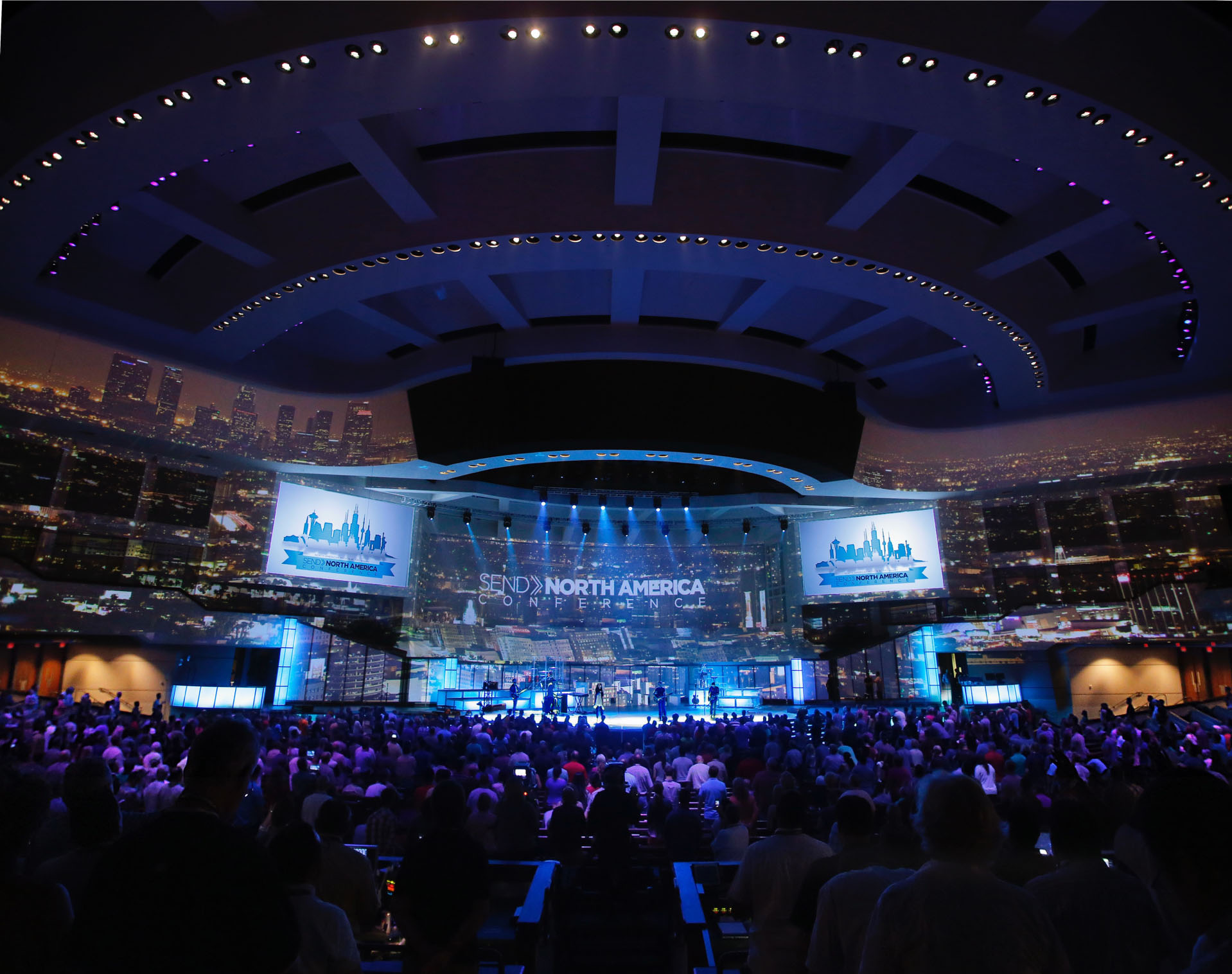
 In the mid-twentieth century, Memphis pastor R. G. Lee quipped that he wouldn’t even say “ahh” at the dentist, a reference to the strong aversion he and other theological conservatives in the Southern Baptist Convention felt toward amillennialism. Some sixty years later, the landscape of the Convention is vastly different when it comes to eschatology. Amillennialists and premillennialists of every variety coexist in all realms of Baptist life, with proponents of each position affirming the inerrancy of Scripture and hardly anyone regarding differing positions on the millennium as an obstacle to cooperation in missions, theological education, evangelism, or cultural engagement.
In the mid-twentieth century, Memphis pastor R. G. Lee quipped that he wouldn’t even say “ahh” at the dentist, a reference to the strong aversion he and other theological conservatives in the Southern Baptist Convention felt toward amillennialism. Some sixty years later, the landscape of the Convention is vastly different when it comes to eschatology. Amillennialists and premillennialists of every variety coexist in all realms of Baptist life, with proponents of each position affirming the inerrancy of Scripture and hardly anyone regarding differing positions on the millennium as an obstacle to cooperation in missions, theological education, evangelism, or cultural engagement.The term “millennium” derives from the Latin words mille anni, “thousand years.” Theologians use “millennium” to describe various interpretations of the “thousand years” referenced six times in Revelation 20:2–7.
*Premillennialism teaches that Christ will return before a thousand-year period of His reign on earth. Within premillennialism, some—known as dispensational premillennialists—believe that Jesus will return to earth twice, once secretly to remove the Church in a “rapture” and once openly to defeat His enemies and end history as we know it. Other premillennialists—known as historic premillennialists—believe that Christ will return only once. Premillennialism was popular among second- and third-century church fathers, and has had proponents in every era of church history. The idea of two separate returns of Christ, however, is a relatively recent innovation, arising in the early 1900s with the Brethren Movement in Britain.
*Postmillennialism teaches that there will be a thousand-year period of peace and righteousness on earth preceding Christ’s return. This position was popular among Baptists at the SBC’s founding in 1845 but became obsolete in the twentieth century, when the horrors of two world wars left few Christians believing the world would transition seamlessly into a period of harmony and peace.
*Amillennialism teaches that Revelation’s “thousand years” is not a future era of earth’s history, but a figurative designation for either Christ’s present reign in the Church or His eternal reign in the new heavens and new earth. Though not popular among Southern Baptist conservatives in the late twentieth century, amillennialism originated in the second and third centuries, like premillennialism, and has been held by believers throughout church history.
The authors of the five articles that follow hold to various stripes of premillennialism and amillennialism. Each believes in the full inerrancy of the Bible, the necessity of personal faith in Christ alone for salvation, and the interpretation of Scripture set forth in The Baptist Faith and Message 2000. Notably, the BF&M does not address the millennium, stating simply that “Jesus Christ will return personally and visibly in glory to the earth” (Article X). SBC LIFE hopes that the exchange of ideas presented here will foster understanding among Southern Baptists of various end-times positions and help us all think more deeply about our Lord’s return.
Jump to:
- Why I Am a Traditional Dispensational Premillennialist by James W. Bryant
- A View of Progressive Dispensationalism by Craig Blaising
- Why I Am a Historic Premillennialist by Nathan A. Finn
- Why I Am a Mid-Trib Premillennialist by Thomas P. Johnston
- Why I Am an Amillennialist by Michael Kuykendall
Why I Am a Traditional Dispensational Premillennialist
by James W. Bryant
I hold to traditional dispensational premillennialism. In short, I believe that at the end of history there will be a rapture of the church, followed by a period of tribulation, followed by Jesus’ establishing a millennial kingdom on earth. I believe that God has divided history into at least three distinct periods and that He works out His purposes for humanity in slightly different ways during each period. Finally, I believe that God has a wonderful future in store for national Israel.
There are two basic reasons why I am a traditional dispensational premillennialist. One is a biblical reason and the other is a hermeneutical reason. Biblically, I was taught during my years as a student at Wheaton College to take the Bible as literally as possible, allowing for the genre being used. When it comes to Christ’s return, the most literal interpretation of Scripture is to regard the second coming as a future event preceded by a rapture of the Church and a period of tribulation.
I was taught as a young boy growing up in a Baptist church in Atlanta that the second coming was either when you accept Jesus into your heart or when you die and go to heaven. I was also taught that the unfulfilled Old Testament prophecies about Israel were fulfilled in the Church. When I was born again and began reading the Bible for myself, I innately sensed that the return of Christ is still in the future and that God’s keeping His promises to Israel had great implications for His keeping His promises to us in the Church as well. My years at Wheaton College confirmed that view. I was able to see at least three dispensations in the Bible: Law, Grace, and Millennium. As hard as I tried, I just could not see Scofield’s seven dispensations in the Bible.
When I arrived at Southwestern Seminary, I began to see other eschatological views which were futurist but differed on the details from what I had concluded. Amillennialism straddles the line between preterist and futurist. Liberal amillennialists do not believe in a future return of Christ at all. Conservative amillennialists do believe in a future return of Christ to the earth, but they see the millennium in the book of Revelation to be an indefinite period of time, and going on in heaven, not on earth. This didn’t seem to be the most literal reading of Scripture.
I soon discovered that premillennialists were divided into three basic groups around their views of the rapture as it relates to the tribulation. There were those who believed in a pre-tribulation rapture (my position), others who believed in a mid-tribulation rapture, and those who believed in a post-tribulation rapture. On the spectrum from allegorical to literal interpretations of Scripture, the pre-tribulation rapture view is as far to the literalist side as you can go. It alone takes the teachings of the Bible as literally as possible. Those who believe in a post-tribulation rapture have to spiritualize the judgment seat of Christ and the marriage supper of the Lamb. I try to read the Bible as literally as possible.
The second reason I am a traditional dispensational premillennialist is a hermeneutical reason. Hermeneutically, it does not seem wise to me to base doctrinal matters on narrative biblical literature. For example, we do not get our ecclesiology from the Book of Acts; it is narrative, not doctrinal. We get it from the Pastoral Letters of Paul. They are doctrinal. In historic premillennialism, Matthew 24 becomes the starting point, but that is narrative literature. If you begin with Matthew, you are going to have explain away a literal reading of 1 and 2 Thessalonians. I begin with the doctrinal literature of Paul in Thessalonians, and then fit Matthew into that framework. Jesus is talking about the second half of the tribulation in Matthew 24. To me it is clear that the second coming of Christ is in two stages. He first returns to the clouds of the sky, and that is when the rapture takes place and the tribulation begins (1 Thessalonians 4:16–17). He returns to the earth. He comes for His saints in stage one, to take them out of tribulation. In stage two He comes with His saints to set up His millennial kingdom (Revelation 20:1–6).
It is interesting to note that both authors of the term “Progressive Dispensationalism” believe as I do in a pre-tribulation rapture of the Church and in a future for Israel. They just do not think those particular views are that important. I would like to point out that not all three views of the rapture can be right. Theoretically they could all be wrong, but because of the law of exclusion they could not all be right. And it is important to be right.
James W. Bryant is senior professor of pastoral theology at Criswell College and a member of First Baptist Church in Dallas, Texas.
A View of Progressive Dispensationalism
by Craig Blaising
The label dispensationalism refers to a group of theologies that, while affirming Jesus Christ as the only way to eternal life and the Church as the Body of Christ, nevertheless also see a future for national Israel in the plan and purpose of God. Dispensationalism interprets God’s covenanted promises to Israel as literally true! They are just as true and just as reliable as the promises of forgiveness of sins and eternal life to everyone who believes in Jesus. God’s Word is consistent in this way.
This means that in order to fully understand the Bible, one needs to recognize that God has a plan for the corporate aspects of human life—its ethnic, national dimensions—just as He does for individual persons. God has a plan for the earth, in fact all of creation, that is finally fulfilled when the heavens and the earth are renewed.
Consequently, dispensationalism rejects the idea that Israel is merely a type or symbol which was destined to disappear in the outworking of God’s plan. The Church does not replace Israel; rather the Church and Israel each point to different aspects of the divine plan. Exactly how that difference is articulated, varies among the different types of dispensationalism.
All variations of dispensationalism understand Israel to refer to a specific ethnic people with national and political features. They likewise see the Church as a multi-ethnic body of people from many nations who are united to Christ by the Holy Spirit. Israel and the Church are categorically distinct. Dispensationalists differ on how the two relate in the overall divine plan as that plan unfolds in history and culminates in eternity.
Some dispensationalists, whom I refer to as classical dispensationalists, distinguish Israel and the Church as “earthly” and “heavenly” peoples respectively. They read the Bible as the story of an earthly people (Israel) whose history is interrupted by a new dispensation (a new arrangement, a new order in history) of a heavenly people (the Church). The history of the earthly people will be resumed once the dispensation of the heavenly people ends, and then will follow the consummation in which heavenly people are blessed in heaven and the earthly people are blessed on earth. The earthly and heavenly people are completely different, with different promises and different rules of life. One needs to differentiate in the Bible which portions of Scripture deal with one and which with the other; they do not overlap. This classical dispensationalism is the dispensationalism of the notes in the original Scofield Reference Bible (1909, 1917). Classical dispensationalism had the advantage of taking God’s promises to Israel seriously, but it did so at the expense of the unity of God’s plan.
In the mid-twentieth century, dispensational theology underwent revision to more adequately account for that unity while still preserving the distinction between Israel and the Church. The changes were reflected in the revision of the notes of the Scofield Reference Bible in 1967. Consequently, I refer to this phase as revised dispensationalism. Revised dispensationalists recognized connections between the Church and God’s prophetic promises to Israel of a new covenant promising forgiveness of sins and the gift of the Holy Spirit. However, they continued to maintain a future for national Israel distinct from the Church together with the pre-tribulational, premillennial eschatology which characterized classical dispensationalism.
Further refinements in the late twentieth century accounting for the unity of the divine plan together with its diversity led to the development of what has been called progressive dispensationalism. Progressive dispensationalism distinguishes Israel and the Church in history and also as aspects of the Kingdom which Jesus preached and which He will bring to consummation at His coming (millennially and eternally). Unlike other dispensationalists, progressive dispensationalists do not see the Church as a separate and distinct people group in the future Kingdom—a group distinct from Jews and Gentiles in that future Kingdom. The Church today points to the fact that all the saved in that future Kingdom, whether Jews or Gentiles, will be equally united to Christ by the Holy Spirit. The promises made to Israel in the past point to the fact that God will bless these same peoples not only in their individual relationship to Christ but also in their national corporate structures as well.
In its present form, the Church is an earnest, a pledge, a partial manifestation of a communion by the Holy Spirit which in its fullness will characterize and stabilize the coming Kingdom promised for Israel and the nations in the Old Testament. The Church is different from Israel past and it is not itself the full reality of the Kingdom that is coming. The Church is not a state or nation (here is the separation of Church and state). However, the Gospel it preaches speaks of spiritual realities that will make it possible for nations to endure and be blessed by God. When Christ returns, He will implement the national, political features of His Kingdom, reconstituting and ruling Israel and the nations while bringing into completion the spiritual realities revealed in and as the Church of believing Jews and Gentiles today. In this way, the Church is part of a progressive revelation of a promised Kingdom, and therein lies the unity of the biblical narrative.
Many of the features of traditional dispensational eschatology, such as pre-tribulational premillennialism, are carried forward by progressive dispensationalism. But progressive dispensationalism offers a balanced reading of both the unfolding unity of the divine plan together with its distinguishing features. Most importantly, it would affirm that ALL the promises of God find their YES in Christ Jesus, to Whom is the glory both now and forever.
Craig Blaising is executive vice president and provost of Southwestern Baptist Theological Seminary and a member of First Baptist Church in Dallas, Texas.
Why I Am a Historic Premillennialist
by Nathan A. Finn
I affirm historic premillennialism, sometimes also called classical premillennialism. Like all premillennialists, I believe the Bible teaches a future period of tribulation when the Antichrist will unite the nations under a satanic false religion and persecute the faithful. At the end of the tribulation, Jesus Christ will return to earth, defeat the Antichrist and his allies, and bind Satan. Christ and His saints will then reign on earth for a thousand years. This “millennium” is a foretaste of the eternal new creation that will commence following the final rebellion, the ultimate defeat of Satan, and the last judgment.
Historic premillennialists reject two ideas that are popular among many modern premillennialists. First, we do not believe the Bible teaches a sharp distinction between Israel and the Church. All believers from all the ages are part of the one spiritual “Israel of God” (Galatians 6:16). Second, we do not believe the Scriptures teach that God will remove the Church prior to the tribulation so that He can resume a unique saving work among the Jews, an idea that presupposes erroneous overemphasis on discontinuity between Israel and the Church. The “rapture” is part of the second coming—the saints on earth will meet Jesus in the air as He returns with the heavenly saints to conquer the Antichrist and establish His millennial rule (1 Thessalonians 4:16–17).
I hold to historic premillennialism for two key reasons. First, I believe it accurately reflects the “one people of God” theme found throughout the entire biblical canon. From Genesis to Revelation, we see a picture of a God who is on mission to rescue sinners from every tribe, tongue, and nation through the perfect life, sacrificial death, and victorious resurrection of Jesus Christ. Under the old covenant, His redemptive purposes centered upon Israel, but always with a view toward the nations. After calling Abraham out of the land of Ur, the Lord promised to make him a great nation and ultimately to bless all the peoples of the earth through him (Genesis 12:1–3). Israel was specially called by the Lord to covenant with Him and testify to His rule, even during its own exile due to covenant unfaithfulness (Exodus 19:4–6; Psalm 67; Isaiah 40–55).
God’s initial promises to Abraham and Israel found their fulfillment in the saving work of Jesus Christ, the Seed of Abraham (Galatians 3:16). Jesus commissioned His followers to proclaim the good news of redemption to all nations (Matthew 28:18–20; Acts 1:8). This Gospel will be successfully preached to and embraced by people from every ethnic group on earth (Revelation 5:9; 7:9–10; 14:6). Under the new covenant, Gentiles have been grafted into the spiritual Israel, and though ethnic Israel has been temporarily hardened, before God is finished “all Israel”—spiritual and physical—will be saved (Romans 11:17–26).
Second, historic premillennialism seems to reflect the most natural reading of Revelation. In the narrative of the book, Revelation 20:4–6 represents a climactic moment during John’s vision. Rather than representing a spiritual reign taking place now among believers—though Christ surely presently rules in the lives of His people—the millennium is depicted as a historical, visible moment in history that follows the tribulation and comes before the final judgment. It is an interlude during which time Christ will visibly rule the entire earth and subdue all His enemies (Psalm 110; 1 Corinthians 15:24–28; Philippians 2:10–11).
Though the millennium follows the tribulation in Revelation, it does not follow a secret rapture. At no point in the book of Revelation are any of God’s people removed from the earth—unless they are martyred. In John’s vision, the martyrs are in heaven, where they watch the events transpiring on earth and long for Christ to return and avenge their deaths, defeat their enemies, and commence His rule (Revelation 6:9–10). The martyrs are told to rest until the full number of those who are to be martyred is completed (Revelation 6:11). Rather than being promised an exit from tribulation via the rapture, God’s people are called to endure in authentic faith in the midst of persecution and even martyrdom with the promise that they will be raised from the dead and reign with Christ (Revelation 2:26–27; 3:21; 20:4).
I believe it is no coincidence that most of the earliest church fathers such as Papias (60–130), Justin Martyr (100–165), Irenaeus (130–202), and Tertullian (160–225) affirmed historic premillennialism. This view best reflects God’s singular plan of salvation and the narrative of the book of Revelation itself. Historic premil-lennialism offers a hopeful vision to Christians facing persecution and all believers who long for the visible reign of Christ alongside His ransomed people and before His conquered enemies. Maranatha!
Nathan A. Finn is associate professor of historical theology and Baptist studies at Southeastern Baptist Theological Seminary and a member of First Baptist Church in Durham, North Carolina.
Why I Am a Mid-Trib Premillennialist
by Thomas P. Johnston
I am a premillennialist who believes in a mid-tribulational rapture of the Church, occurring three and a half years into a seven-year period of tribulation. Because other authors have defended the premillennial aspect of my position (see the essays by Nathan Finn, James Bryant, and Craig Blaising), I will focus on defending the mid-tribulational rapture. Admittedly, there seems to be a sovereign mystery of expectancy built into end time prophecies. Nonetheless, God reveals enough information for us to glean some important details about Christ’s return.
As to the rapture, two Scriptures are foundational to this discussion: 1 Thessalonians 4:17 and Revelation 3:10. In the first Scripture, Paul spoke of living Christians being caught up in the clouds to meet Jesus in the air. In the second Scripture, John penned a promise of God that those who persevere will be kept from the hour of trial that is to come upon the whole world. Putting them together, we know that believers will both have to persevere through tribulation and be caught up in the air with Jesus. The idea of a mid-tribulational rapture fits these verses together well.
The idea of seven years of tribulation and its division into two parts comes from Daniel 9:27:
He will make a firm covenant with many for one week, but in the middle of the week he will put a stop to sacrifice and offering. And the abomination of desolation will be on a wing of the temple until the decreed destruction is poured out on the desolator.
Now, “one week” is a prophetic “seven years.” But when during these seven years will believers be raptured—at the beginning, middle, or end? The answer to this question leads to three rapture positions: pre-, mid-, and post-tribulation rapture. My position is that the mid-tribulation position best explains the Bible’s emphasis on the middle of the seventieth week of Daniel.
The following are the four designations used to divide the seven years of tribulation in the books of Daniel and Revelation:
- In the middle of the week (Daniel 9:27)
- Time, times, and half a time (Daniel 7:25; 12:7)
- Forty-two months (Revelation 11:2)
- 1,290 days (Daniel 12:11)
All of these numbers divide the seven-year tribulation into two segments or time periods. As Gleason Archer wrote, “Neither the pretribulationists nor the posttribulationists have been able to furnish a convincing explanation for this emphasis on the midpoint of Daniel’s seventieth week.” Some elements of the tribulation relate to the first three and a half years, and some elements relate to the second three and a half years, with a rapture taking place sometime near the mid-point.
Three items precede the rapture according to 1 Thessalonians 4:16:
- The shout,
- The voice of the archangel, and
- The sound of the trumpet.
In Revelation there is one trumpet sound in 4:1 and seven trumpets from 8:7 to 11:19. There are shouts and great voices speaking throughout the Book of Revelation. Second Thessalonians 2:3–12 adds further information to this puzzle. So the quandary remains, how do the ideas from these books congeal into a unified whole?
Chronologically, it appears from Daniel 9:27 that during the first three and a half years, a world dictator will make a contract with Jewish leaders. Part of that contract will include the re-inauguration of the Old Testament Temple sacrifices in Jerusalem. Men will be saying, “Peace, peace,” when in reality there will be a time of war, famine, and death, as mentioned by Jesus in His Olivet Discourse. At the end of this first three and a half years, the Antichrist will put an end to the sacrificial system, cancelling his contract with the Jewish leaders (Daniel 12:11). At this point he will exalt himself even more, asserting that he is above God (2 Thessalonians 2:4). He will speak great blasphemies (Revelation 13:6), make war with the saints still on earth (Revelation 13:7), and will cause all men to take the sign of the Beast (Revelation 13:16–17).
Then the rapture of the saints will come, as described in Revelation 14:14–20. Two beings will reap the earth. The first being, “One like the Son of Man,” will sit on a cloud and reap a gladsome harvest. He will bring to Himself those He has called unto salvation. Then another being, an angel, will thrust his sickle to reap the earth and gather another group. These people will take part in a war outside “the city.” Their blood will flow deep and long.
In the final three and a half years of the tribulation, those who remain will receive the seven bowls of God’s wrath (Revelation 16–17). Then Christ will come and establish His millennial kingdom on earth for one thousand years.
Thomas P. Johnston is professor of evangelism at Midwestern Baptist Theological Seminary and a member of Lenexa Baptist Church in the Kansas City, Missouri, area.
Why I Am an Amillennialist
by Michael Kuykendall
I believe amillennialism offers the best view for understanding the end times. Actually, I prefer the label “eclectic” to describe my position on the end times because I see value in all the viewpoints and attempt to emphasize the strengths of each position. But when it comes to Revelation 20, amillennialism is the best alternative. This means I observe these four features—the millennium symbolizes the entire Church age between the first and second comings of Christ; Revelation is primarily symbolic literature; there is no “rapture” to avoid the Great Tribulation; and the structure of Revelation underscores an amillennial interpretation.
First, the millennium is not a literal one thousand years but rather symbolizes the period between the time of Christ and His return. Reflecting Jesus’ “already-not yet” teaching on the Kingdom of God, we live in the millennium now but await full consummation at the second coming. Jesus inaugurated the millennium with His first coming, not His second. Thus, a more accurate term to describe amillennialism is realized or inaugurated millennialism. Since one thousand is a common symbolic number (Psalm 50:10; 2 Peter 3:8), it stresses completeness and fullness.
Second, amillennialists stress the figurative language found in apocalyptic literature such as Revelation. We attempt to find the meaning of the symbols before searching for literal specifics. For example, amillennialists hold that the Old Testament promises made to the nation of Israel are symbolically fulfilled in Christ and the Church during this present age, the millennium. The Church is the spiritual “Israel of God” (Galatians 6:16), enlarging, spiritualizing, and progressively fulfilling God’s original intention for His people (cf. Exodus 19:5–6; 1 Peter 2:9–10).
Third, amillennialists are post-tribulational in their view of the “rapture.” The Church has experienced tribulation throughout its history, but things will worsen toward the end of time. No one, however, receives a free pass on persecution. Revelation stresses the militant Church on earth, armed with the Gospel message. The rapture is a relatively new doctrine (1830s). The idea that the church must be raptured in order for God to work through His people the Jews assumes a separation between two peoples of God. Bible writers, however, stressed unity between ethnic Israel and the Church by using Jewish terminology to refer to Gentile Christians (Ephesians 2:11–22; Philippians 3:2–3; James 1:1; 1 Peter 1:1; Revelation 1:5–6). Ethnic Israel must not be separated from the multi-ethnic Church (Galatians 3–4; Romans 2:28–29; 4:1–11; 9:6–8). The Church does not replace Israel as the people of God—it expands and universalizes “Israel” into the Church, the new, spiritual Israel, composed of Jews and Gentiles.
Finally, the structure of Revelation supports an amillennial view. Revelation is composed of several individual visions, expertly crafted together by John. Revelation does not relate chronologically consecutive events. Rather, each vision repeats the same information from different perspectives. Some interpreters see four, seven, even twelve visions that make up Revelation’s structure (e.g., 1:9–3:21; 4:1–5:14; 6:1–17, 8:1–5; 7:1–17; 8:6–9:21, 11:14–19; 10:1–11:13; 12:1–15:4; 15:5–16:21; 17:1–19:10; 19:11–21; 20:1–15; 21:1–22:5). John weaves some themes throughout all the visions to connect them. Significantly, most visions begin with John’s audience and end at the eschaton. The ends of visions tend to include cosmic imagery such as an earthquake and dissolution of earth (6:12–14; 11:13, 19; 16:17–21); Armageddon (9:14–19; 14:20; 16:12–16; 19:17–19; 20:8–9); the second coming and eternal bliss for believers (7:9–17; 11:15–17; 14:1–5, 14–16; 19:11–16; 21:1–22:5); and Judgment Day for the wicked (6:16–17; 11:18; 14:8–11, 17–20; 16:19; 19:20–21; 20:10–15).
When Revelation 20 is understood as an independent vision, the same features arise. And I saw (20:1) indicates a new vision has started. At Christ’s resurrection, Satan was effectively “bound” (20:2–3). His power is limited. He is no longer free to deceive the nations (John 12:31; Colossians 2:15). Nevertheless, good and evil continue to coexist (Matthew 13:24–30). Toward the end of history, Satan will be loosed and permitted to spread havoc.
Meanwhile, God’s saints reign during the millennium (20:4–6). The “first resurrection,” referenced in Revelation 20:5–6, is the spiritual resurrection that occurs at the believer’s physical death (1 Corinthians 15:22). Christ presently reigns in heaven with the souls of deceased believers. The second resurrection is physical. Glorified bodily resurrection occurs at the second coming (2 Corinthians 5:1–8; 1 Thessalonians 4:13–18). The resurrection of unbelievers (“rest of the dead”) to face judgment is elaborated in 20:12–13. Satan’s release and the final battle are envisioned in 20:7–10. But this is not another “final” battle a thousand years after Armageddon. It is Armageddon—another picture of the same end-time battle described in previous visions. Lastly, Christ’s return leads to final judgment for the wicked and eternity for the saints (20:11–15).
In sum, amillennialism stresses the primary message of Revelation—the clarion call for militant, persevering witness for Christ, even unto death. It does not get caught up in end-time fever. It offers a simple chronology. It takes symbolism seriously, not literally. Amillennialism reflects the dominant position of the majority of Christians for the longest period of time.
Michael Kuykendall is professor of New Testament studies at Golden Gate Baptist Theological Seminary and a member of Catalyst Community Church in Oregon City, Oregon.



-headshot.jpg)




















